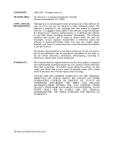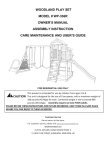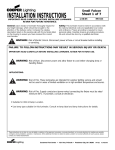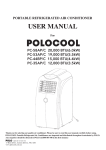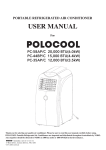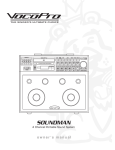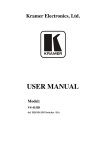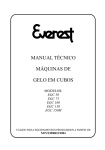Download Sears Canada Service Manual
Transcript
Sears Canada Service Manual Treadmills Models 30750, 30727 Table of Contents >> Table of Contents Section One Safety Instructions Recommended Tools Parts Diagrams >> 30750 >> 30727 Maintenance >> Preventative >> Lubrication >> Tensioning & Alignment Proper Heart Rate Usage Section Two 3 5 6 7 Horizon Fitness “5-Step” Diagnostic Process Wiring Diagrams and Schematics Resetting the Incline Motor Voltage Checks Engineering Mode 13 15 18 19 26 Section Three 8 9 10 11 | 2008 Sears CA Treadmill Service Manual [rev 1.0] Troubleshooting Exploded Drawings >> 30750 >> 30727 28 43 44 Section One | Safety Instructions Safety Instructions >> Treadmills WARNING STATEMENTS INDICATE A PARTICULARLY DANGEROUS ACTIVITY. YOU SHOULD BE EXTREMELY CAUTIOUS WHEN DOING THE FOLLOWING: • Removing power from the treadmill, or removing the power cord from the wall outlet. Always ensure that the treadmill is unplugged from the wall outlet when you inspect or adjust the treadmill, or when you isolate, remove, or replace a treadmill component. • Removing the motor cover exposes high voltage components and potentially dangerous machinery. Exercise extreme caution when you perform maintenance procedures with the motor cover removed. • During service operations you will be very close to moving machinery and high voltage components. When you perform maintenance procedures with the hood removed, remove jewelry (especially from ears and neck), tie up long hair, remove neckties, and do not wear loose clothing. • When the treadmill is operating, the capacitor will hold a lethal amount of charge. Do not touch the capacitor as serious injury or death might result. • When the treadmill is turned off and the power cord is removed from the wall outlet, the capacitor will hold voltage for 30-60 seconds. Allow the capacitor to discharge for a period of one minute before you touch or work near the capacitor. Do not attempt to discharge the capacitor by any other means. • Exercise caution when touching any wire or electrical component during treadmill operation. • When it is necessary to lift the treadmill, ensure that the treadmill has adequate support. Do not lift the treadmill by the front. SAFETY GUIDELINES YOU SHOULD KNOW AND FOLLOW INCLUDE: • Read the owner’s manual and follow all operation instructions. • Operate the treadmill on a solid, level surface. Locate the rear of the treadmill at least four feet from walls or furniture. Keep the area behind the treadmill clear. • Visually check the treadmill before beginning service or maintenance operations. If it is not completely assembled or is damaged in any way, exercise extreme caution while operating and checking the treadmill. • When operating the treadmill, do not wear loose clothing. Do not wear shoes with heels or leather soles. Check the soles of your shoes and remove any embedded stones. Tie long hair back. • Use care when getting on or off the treadmill. Use the handrails whenever possible. Do not get on or off the treadmill when the running belt is moving. • Before starting the running belt, straddle the belt by placing your feet firmly on the guide rails of the treadmill. You should also step off the belt and onto the guide rails of the treadmill after turning off the running belt. • Do not rock the unit. Do not stand or climb on the handrails, electronic console, or motor cover. • Do not set anything on the handrails, electronic console, or motor cover. Never place liquids on any part of the treadmill. • To prevent electrical shock, keep all electrical components, such as the drive motor, power cord, and circuit breaker away from water and other liquids. • Do not use accessory attachments that are not recommended by the manufacturer-such attachments might cause injuries. • Turn off the treadmill when adjusting or working near the rear roller. Do not make any adjustments to the running belt when someone is standing on the machine. • Keep all loose items away from the treadmill running surface. A treadmill running belt will not stop immediately if an object becomes caught in the belt or rollers. 2008 Sears CA Treadmill Service Manual [rev 1.0] | Section One | Safety Instructions WARNING Connect this unit to a properly grounded, dedicated 20-amp outlet only. See grounding instructions. GROUNDING INSTRUCTIONS This product must be grounded. If a treadmill should malfunction or breakdown, grounding provides a path of least resistance for electrical current to reduce the risk of electrical shock. This product is equipped with a cord having an equipment-grounding conductor and a grounding plug. The plug must be plugged into an appropriate outlet that is properly installed and grounded in accordance with local codes and ordinances. WARNING Improper connection of the equipment-grounding conductor can result in a risk of electric shock. Check with a qualified electrician if you are in doubt as to whether the product is properly grounded. Do not modify the plug provided with the product, if it will not fit in the outlet; have a proper outlet installed by a qualified electrician. Grounded Outlet Adapter Metal Screw Grounding Pin Grounded Outlet Box TAS For Grounding Screw SAFETY TIPS • Never use the treadmill before securing the safety tether clip to your clothing. • If you experience chest pains, nausea, dizziness, or shortness of breath, stop exercising immediately and consult your physician before continuing. • Do not wear clothes that might catch on any part of the treadmill. • Keep power cord away from heated surfaces. • Keep children off of treadmill at all times. • Do not use treadmill outdoors. • Unplug treadmill before moving it. • Do not remove the treadmill motor cover or roller covers. • Treadmill should be plugged into a dedicated 20 amp circuit for optimal performance. | 2008 Sears CA Treadmill Service Manual [rev 1.0] Section One | Recommended Tools >> Recommended Tools and Equipment The following list is a summary of the tools and equipment required by the procedures in this manual. Tools are not supplied by Horizon Fitness. • Phillips screwdrivers • Anti-static wrist strap (when handling electronic parts) • Flat-head screwdrivers • Digital multi-meter • Drive belt tension gauge • Allen wrench set (Metric) • Open-end wrenches of assorted sizes (Metric) • Clamp-on amp meter • 1/2” drive ratchet and sockets of assorted sizes • Blue Thread Lock • Cable ties • *Motor commutator stone • Needle nose pliers • Damp cloth • Rubber mallet • Hammer • Drop cloth • Ruler • Snap ring pliers • Wire cutters *Available through Horizon Fitness at Cost. 2008 Sears CA Treadmill Service Manual [rev 1.0] | Section One | Parts Diagrams >> Treadmill Parts Diagram | 30750 Control Panel CONTROL PANEL Console CONSOLE WATER BOTTLE POCKET Pocket Water Bottle Safety Key Placement SAFTEY KEY PLACEMENT Console Mast CONSOLE MAST On Off Switch ON/OFF| SWITCH Motor Cover MOTOR COVER Circuit Breaker CIRCUIT BREAKER Running BeltRUNNING | Running Deck BELT/RUNNING DECK RAIL SideSIDERail Roller ROLLER EndEND Cap CAP RearREAR Roller ROLLER Adjustment Bolts ADJUSTMENT BOLTS | 2008 Sears CA Treadmill Service Manual [rev 1.0] Power POWER CORDCord TRANSPORT WHEELWheel Transport Section One | Parts Diagrams >> Treadmill Parts Diagram | 30727 SPEAKERS Speakers WaterWATER Bottle Pocket BOTTLE HOLDER LCD Display LCD DISPLAY Audio In Jack AUDIO IN JACK Console CONSOLE Reading Rack READING RACK Grip Pulse Handrails GRIP PULSE HANDRAILS Console MastMAST Cover CONSOLE COVER Support SUPPORTBar BAR On | Off Switch ON/OFF SWITCH Circuit Breaker CIRCUIT BREAKER POWER CORD Power Cord MP3 Pocket MP3 POCKET Console CONSOLE FANFan Handlebar HANDLEBAR Safety Placement SAFETY KEYKey PLACEMENT Headphone HEADPHONE JACK Jack Console Mast CONSOLE MAST Motor Cover MOTOR COVER Foot Lock FOOT LOCK LATCHLatch RUNNING BELTBelt / RUNNING DECK Running | Running Deck Side Rail SIDE RAIL Orthoflex Gel Cushion ORTHOFLEX GEL CUSHION Transport Wheel TRANSPORT WHEEL Roller End ROLLER END CAP Cap RearREAR Roller ROLLER ADJUSTMENT BOLTS Bolts Adjustment 2008 Sears CA Treadmill Service Manual [rev 1.0] | Section One | Maintenance Maintenance >> Treadmill Preventative Maintenance Procedures Cleanliness of your treadmill and its operation environment will keep maintenance problems and service calls to a minimum. For this reason, we recommend that the following preventive maintenance schedule be followed. AFTER EACH USE (DAILY) Clean and inspect, following these steps: • Turn off the treadmill with the on/off switch, then unplug the power cord at the wall outlet. • Wipe down the running belt, deck, motor cover, and console casing with a damp cloth. Never use solvents, as they can cause damage to the treadmill. • Inspect the power cord. If the power cord is damaged, contact Horizon Fitness. • Make sure the power cord is not underneath the treadmill or in any other area where it can become pinched or cut. • Check the tension and alignment of the running belt. Make sure that the treadmill belt will not damage any other components on the treadmill by being misaligned. EVERY WEEK Clean underneath the treadmill, following these steps: • Turn off the treadmill with the on/off switch, then unplug the power cord at the wall outlet. • Fold the treadmill into the upright position, making sure that the lock latch is secure. • Move the treadmill to a remote location. • Wipe or vacuum any dust particles or other objects that may have accumulated underneath the treadmill. • Return the treadmill to its previous position. EVERY MONTH - IMPORTANT! • Turn off the treadmill with the on/off switch, then unplug the power cord at the wall outlet. • Inspect all assembly bolts of the machine for proper tightness. • Turn off the treadmill and wait 60 seconds. • Remove the motor cover. Wait until ALL LED lights turn off. • Clean the motor and lower board area to eliminate any lint or dust particles that may have accumulated. Failure to do so may result in premature failure of key electrical components. • Vacuum and wipe down the belt with a damp cloth. Vacuum any black/white particles that may accumulate around the unit. These particles may accumulate from normal treadmill use. Note: Maintenance is NOT covered under manufacturer’s warranty. | 2008 Sears CA Treadmill Service Manual [rev 1.0] Section One | Maintenance Maintenance >> Treadmill Lubrication | 30727 Only EVERY 6 MONTHS OR 150 MILES It is necessary to lubricate your treadmill running deck every six months or 150 miles to maintain optimal performance of your treadmill. Once the treadmill reaches 150 miles, the console will prompt you to lubricate the treadmill. Only use lubricant provided by Horizon Fitness! • Turn off the treadmill with the on/off switch, then unplug the power cord at the wall outlet. • Loosen both the rear roller bolts. (For best results, place two removable marks on both sides of the frame and note roller position). Once the belt is loosened, take the bottle of lubricant and apply it to the entire top surface of the running deck. Tighten both rear roller bolts (matching up the marks for proper position) to original position. After you have applied lubricant, plug in the power cord, insert the safety key, start the treadmill and walk on the belt for two minutes to spread the lubricant. • Lubricate the air shocks with Teflon based spray. • Once lubrication is complete, reset the console by pressing and holding ‘STOP’ and Speed (s) buttons for 5 seconds. LUBRICATION Running Belt Running Deck 2008 Sears CA Treadmill Service Manual [rev 1.0] | Section One | Maintenance Maintenance >> Tensioning and Aligning the Running Belt If you can feel a slipping sensation when running on the treadmill, the running belt must be tightened. In most cases, the belt has stretched from use, causing the belt to slip. This is a normal and common adjustment. Make sure that the unit is turned off and not running. To eliminate this slipping, tension both the rear roller bolts with the appropriate sized Allen wrench, turning both the left and right bolt 1/4 TURN as shown below. Try the treadmill again to check for slipping. Repeat if necessary, but NEVER TURN the roller bolts more than 1/4 turn at a time. Belt is too far to the left side. Belt is too far to the right side. 1 | If the running belt moves rapidly to one side when performing the next step, press the Stop button immediately. • Turn on the treadmill. With the treadmill speed between 3-4mph, stand behind the treadmill and watch the movement of the running belt. DO NOT STAND ON THE TREADMILL AND DO NOT TOUCH THE TREADMILL WHILE PERFORMING THIS PROCEDURE. As you watch the running belt, make sure that the belt runs without moving from one side to the other and that the belt is centered between the side rails. 2 | If the running belt is not tracking properly, follow the procedures below: • If the running belt tracks to the left, turn the left roller bolt clockwise 1/4 of a turn, keeping the belt tension in mind. Over-tightening the running belt may cause damage to the running belt and roller bearings. • If the running belt tracks to the right, turn the right roller bolt clockwise 1/4 of a turn, keeping the belt tension in mind. Over-tightening the running belt may cause damage to the running belt and roller bearings. 10 | 2008 Sears CA Treadmill Service Manual [rev 1.0] Section One | Proper Heart Rate Usage >> Proper Heart Rate Usage HAND GRIPS | THUMB PULSE Place the palm of you hands directly on the grip pulse handlebars. Both hands must grip the bars for your heart rate to register. It takes 5 consecutive heartbeats (15-20 seconds) for your heart rate to register accurately. When gripping the pulse handlebars, do not grip tightly. Holding the grips tightly may elevate your blood pressure. Keep a loose, cupping hold. You may experience an erratic readout if consistently holding the grip pulse handlebars. Make sure to clean the pulse sensors to ensure proper contact can be maintained. TROUBLESHOOTING-HEART RATE Check your exercise environment for sources of interference such as fluorescent lights, computers, underground fencing, home security systems or appliances containing large motors. These items may cause erratic heart rate readouts. You may experience an erratic readout under the following conditions: • Gripping the heart rate handlebars too tight. Try to maintain moderate pressure while holding onto the heart rate handlebars. • Constant movement and vibration due to constantly holding the heart rate handlebars while exercising. If you are receiving erratic heart rate readouts, try to only hold the grips long enough to monitor your heart rate. • When you are breathing heavily during a workout. • When your hands are constricted by wearing a ring. • When your hands are dry or cold. Try to moisten your palms by rubbing them together to warm them. • Anyone with heavy arrhythmia. • Anyone with arteriosclerosis or peripheral circulation disorder. • Anyone whose skin on the measuring palm is especially thick. 2008 Sears CA Treadmill Service Manual [rev 1.0] | 11 Table of Contents >> Section Two Horizon Fitness “5-Step” Diagnostic Process Wiring Diagrams and Schematics >> Digital Drive 30727 >> Wiring Diagram 30750 >> Power Source Resetting the Incline Motor Voltage Checks >> No Motor Movement >> Motor | AC Wire >> Console Cable >> Speaker Amp Board >> 9 Wire Console Cable (30750) >> 12 Wire Console Cable (30727) >> Incline Wire Engineering Mode (30727) 12 | 2008 Sears CA Treadmill Service Manual [rev 1.0] 13 15 16 17 18 19 21 22 22 23 24 25 26 Section Two | Horizon Fitness “5-Step” Diagnostic Process >> Horizon Fitness “5-Step” Treadmill Diagnostic Process The following steps are provided as routine checkpoints when diagnosing problems on a Horizon Fitness treadmill. If followed correctly, these checkpoints should help diagnos the majority of problems that may be encountered. Step 1 | Proper supplying power to treadmill. • Make sure the treadmill is not on an extension cord, surge protector or GFCI circuit. Extension cords and surge protectors create energy loss, which prevents proper voltage from being supplied to the treadmill. • Make sure the treadmill is on a dedicated circuit. Horizon Fitness recommends a 20 amp dedicated circuit, but a 15 amp dedicated circuit may be sufficient. • Make sure that proper voltage is being supplied from the wall outlet. WARNING Hazardous voltages will be tested in the following procedure. Exercise extreme caution when performing these procedures. Do not connect or disconnect any wiring, connectors, or other components with the power applied to the treadmill. • Disconnect the treadmill power cord from the wall outlet. Using an AC voltmeter, verify that the proper AC voltage is present at the wall outlet. Nominal 120 volts AC may vary between approximately 105 volts AC and 135 volts AC. If the AC voltage is missing or incorrect, check the AC service or consult an electrician. 120 VAC Step 2 | Proper Wiring • Verify that all wires are secure and attached in the correct position. • Verify that there aren’t any pinches or cuts in any of the wires, especially the console cable connecting from the motor control board to the upper board. Replace any wires that are pinched or cut. 2008 Sears CA Treadmill Service Manual [rev 1.0] | 13 Section Two | Horizon Fitness “5-Step” Diagnostic Process Step 3 | Proper Motor Function • Verify that the treadmill is properly lubricated and drive motor is operating at the proper amperage rating. To verify the current draw, place a clamp meter around the red motor wire. 02.31 • Remove the brush covers on the drive motor and inspect the brushes and the motor commutator for any uneven wear. If the surface of the motor brush is pitted, rough, has burn marks, or the commutator has a black residue on it, replace the motor. Step 4 | Proper Speed Calibration • To ensure proper belt speed and proper calibration use engineering mode to verify that machine is running in MPH not KM. • Auto-calibrate the machine from engineering mode if the belt speed is erratic or the belt speed does not correspond to what is displayed on the console. Step 5 | Voltage Checkpoints • Verify that proper voltage is being transferred through the console cable. 14 | 2008 Sears CA Treadmill Service Manual [rev 1.0] Section Two | Wiring Diagrams and Schematics >> Digital Drive Wiring Diagram (30727) 30727 Digital Ground Digital Ground BLACK WHITE RED BLUE BLACK EL - Vcc (+2.5v) EL - Pot Gnd RPM Power Voltage (+15V) Power Voltage (+15V) Speed Command pwr RELAY DOWN Incline UP Incline Optic Speed Sensor +2.5vdc EL. Pol EL. GND +GND PULSE +5V GND GND BLACK RED Speed Sensor WHITE GREEN Incline Motor MCB BLACK RED WHITE BLACK GREEN Drive Motor 0-90 VDC WHITE BLACK BREAKER GREEN Power Cord 110-120 VAC LCD Board 071206 1 9 059940-A 9 1 1 17 - 1 HR2 2 感應器握管 VREF+ ELE N/A GND GND RPM-IN VDD VDD S-PWM1 MOTOR DOWN UP + COM1 D1 COM2 D2 D3 D4 NULL 074973 1 UP DOWN MOTOR S-PWM1 VDD VDD RPM-IN GND GND N/A ELE VREF+ POWER+ 2 071206 SIGN GND 1 7 GND A座 075922 COM1 D1 COM2 D2 D3 D4 空 1 3 safekey COM6 D1 D2 D3 D4 F+ N/A F- COM5 D4 D5 D6 4 1 功放板 1 074949 (Upper Control Board) 1 072156 2 PCB(SXT7.7) KEYPAD 2 1 1 3 2 1 076820 076819 5 078691 078690 070674 Speaker(L) Speaker(R) 002671-A 3 3 COM6 D1 D2 D3 D4 5 1 COM5 D4 D5 D6 AUDIO IN 1 078687 078687 Incline - 073705 1 073303 4 4 1 1 插至PCB A座 HR1 2 075204 1 - 34 12 18 + AUDIO OUT 077117 067517-00 Incline + Fan Speed - Speed + START STOP 2008 Sears CA Treadmill Service Manual [rev 1.0] | 15 30750 Section Two | Wiring Diagrams and Schematics >> Wiring Diagram (30750) Pulse Receiver FingerFinger Pulse Receiver Console Cable Console Cable Switch Key Switch Key NG NG Safe Key Safe Key 16 | 2008 Sears CA Treadmill Service Manual [rev 1.0] Section Two | Wiring Diagrams and Schematics >> Power Source Wiring Diagram To Motor Control Board D E F C A A B F C Socket On | Off Switch Breaker A – Socket wire to breaker or on/off switch. Wire Length will determine connection point. B – Ground C – Socket wire to breaker or on/off switch. Wire Length will determine connection point. D – On/Off switch to motor control board. E – On/Off switch to motor control board. F – On/Off switch to breaker. Note: Wires A & C are interchangeable. 2008 Sears CA Treadmill Service Manual [rev 1.0] | 17 Section Two | Resetting The Incline Motor >> Resetting the Incline Motor after replacing the Motor Control Board Tools Required: • Phillips Screwdriver • 17mm Socket • 17mm Combination Wrench Procedure: 1 | Turn off power to the treadmill and unplug power cord from wall outlet. 2 | Replace the Motor Control Board. 3 | Fold treadmill into locked position. 4 | Undo bolt that attaches the elevation tube to the bottom of the machine (F1). F2 F1 17 mm Nut 17 mm Bolt Proper Zero Shaft Position 5 | Power up the machine and let the incline spin freely in the tube until it reaches its “zero” position, and then turn power off. 6 | Spin shaft manually until it is almost flush with the incline motor casing and only about 1 thread is visible (F2). 7 | Reinsert bolt and power up the machine. 8 | Test the incline function and calibrate the unit. 18 | 2008 Sears CA Treadmill Service Manual [rev 1.0] Section Two | Voltage Checks >> No Motor Movement Voltage Checkpoints Upper Board Checkpoints Procedures: Using a dc volt meter (if non-auto ranging set for the 20vdc range), test the voltage at the grey and again at the white console cable connections using the yellow, orange or red wires as ground. Two tests are to be performed; test once with power on before the treadmill is started and again after Start is pressed. Desired Results: The voltage charts contain typical desired results on a fully functional system. A variance from the norm would indicate a defective component. Checkpoint Console Cable Grey to Yellow (Gnd) Voltage Before Start 0.0 vdc Console Cable White to Yellow (Gnd) 4.3 +/- .3 vdc Voltage After Start 0.3 +/- .3 vdc, increases as speed increases. (as shown on console) 0.0 vdc Lower Board Checkpoints Console Cable Connection Procedures: Using a dc volt meter (if non-auto ranging set for the 20vdc range), test the voltage at the grey and again at the white console cable connections using the yellow, orange or red wires as ground. Two tests are to be performed; test once with power on before the treadmill is started and again after Start is pressed. Note: this is the same procedure as the upper board console cable connection. If results vary from the upper board, the console cable is the likely cause and a continuity check should be performed. Desired Results: The voltage charts contain typical desired results on a fully functional system. A variance from the norm would indicate a defective component. Checkpoint Console Cable Grey to Yellow (Gnd) Voltage Before Start 0.0 vdc Volatge After Start 0.3 vdc, increases as speed increases. (as shown on console) Console Cable White to Yellow (Gnd) 4.3 vdc 0.0 vdc Note: 2.75 Hp motors and higher: the reading on the console cable -white to yellow (gnd) is 1.6 + or - .3vdc Digital Speed Sensor Connection Procedures: Using a dc volt meter (if non-auto ranging set for the 20vdc range); test the voltage at the red wire and again at the yellow wire using the blue, black or black as ground. The yellow wire should be measure twice, once with the optic speed sensor obstructed and once not obstructed. This can be done by slowly turning the motor and aligning the tines or open spaces of the optic disk with the sensor. Desired Results: The voltage charts contain typical desired results on a fully functional system. A variance from the norm would indicate a defective component. Checkpoint Yellow Digital Speed Sensor Red Digital Speed Sensor Voltage With Sensor Obstructed 5.0 +/- 0.4 vdc 5.0 +/- 0.4 vdc Voltage With Sensor Not Obstructed 0.3 vdc 5.0 +/- 0.4 vdc 2008 Sears CA Treadmill Service Manual [rev 1.0] | 19 Section Two | Voltage Checks >> No Motor Movement Voltage Checkpoints Continued Drive Motor Connection Procedures: Using a dc volt meter (if non-auto ranging set for the 200vdc range), test the voltage at the red and black motor leads with the motor still attached. Note: This should be tested after the console cable and optic sensor points because they can give the same results as a defective lower board. Note: A non-functional system may still have a voltage present with no motor attached. For accurate results, the motor must be attached when the voltage is checked. Desired Results: The voltage charts contain typical desired results on a fully functional system. A variance from the norm would indicate a defective component. Checkpoint Voltage Before Start Across Motor Out, 0.0-22.5 vdc No Motor Attached Across Motor Out, 0.0 vdc W/ Motor Attached Voltage After Start @ 0.5mph 0.0-22.5 vdc Voltage After Start @ 10.0mph 2.5- 0 vdc 80-100.0 vdc 0.0-22.5 vdc Drive Motor Checkpoints Procedures: Unplug the motor from the lower board. Using a dc volt meter (if non-auto ranging set for the 20vdc range), attach volt meter leads directly into the motor leads and turn the running belt. Desired Results: The motor should generate 5-15 vdc depending on the speed it is turned. Procedures: Unplug the motor from the lower board. Using an ohm meter (if non-auto ranging set for the 200 ohm range), attach ohm meter leads directly into the motor leads. Desired Results: The motor should read approximately 1.0-1.5 ohms. 20 | 2008 Sears CA Treadmill Service Manual [rev 1.0] Section Two | Voltage Checks >> Motor Voltage Check | Spin motor flywheel to produce voltage 1.20 V DC >> AC Wire Voltage Check 7"$ "$8JSFT 2008 Sears CA Treadmill Service Manual [rev 1.0] | 21 Section Two | Voltage Checks >> Console Cable Voltage Check V DC GND GND M VD P Mo Dow UP To check the voltage of a specific function (i.e. elevation, motor control, etc), place the negative lead of your multi-meter on pin B3, B4 or B5, and place the positive lead on the desired pin. Follow the voltage charts on p23 (9wire) and p24 (12wire). Note | 1: Wire colors are subject to change. Note | 2: It may be necessary to remove the glue from the console cable to access the pins. >> Speaker Amp Board Voltage | 30727 Only wer Acepo CON2 D12 JOHNSON Voltage In Voltage Out 120v 12v 22 | 2008 Sears CA Treadmill Service Manual [rev 1.0] Section Two | Voltage Checks >> 9 Wire Console Cable Voltage Chart (DC Volts) Model 30750 Polarity tab will face User P1: Up P1: Incline Incline Up P2: Incline Down Incline Down P3: P3: GND GND P4: Power Voltage (to UCB) Power Voltage (to UCB) P5: Drive Drive Motor Relay P5: Motor Relay Stop P6: Stop P7: Incline Incline Pot/VREF+ P7: Pot | VREF+ P8: VCC | ELE P8: Incline Incline VCC/ELE RPM P9: RPM Polarity tab will face Polarity tab will face User User Wire Color Function Console Cable Voltage no wires cut Voltage at UCB after wire’s cut Voltage at MCB after wire’s cut Physical Symptoms-If Wire Cut 1 Red Incline Up 0.0 vdc before started, +1.9 vdc while inclining, 0.0 vdc while declining. Voltage constant while inclining/ declining. 2.5 vdc b/f start, 5.0 vdc after start. 3.7 vdc b/f start, 0.0 vdc after start. Incline motor will go up but not down. 2 Brown Incline Down 0.0 vdc before started, 0.0 vdc while inclining, +1.9 vdc while declining. Voltage constant while inclining/ declining. 2.5 vdc b/f start, 0.8 vdc after start. 0.0 vdc b/f start, 0.1 vdc after start. Incline motor will go down but not up. 3 Orange GND n/a ground 0.0 vdc 0.0 vdc 4 Yellow Power Voltage (to UCB) +15 vdc constant range. 0.0 vdc 14.55 vdc Console will not turn on. 5 Green Drive Motor Relay +1.6 vdc before started, 0.0 vdc after started. 1.4 vdc b/f start 0.8 vdc after start 0.0 vdc b/f start 1.4 vdc after start No belt movement. 6 Blue Stop Constant 0.53 vdc-0.69 vdc 3.6 vdc when the safety key is removed. Will remain at 3.6 vdc until Start is pressed. 5.0 vdc safe off 1.3 vdc safe on 1.7 vdc running 1.9 vdc paused 16.6 vdc safe off 0.0 vdc safe on and running No physical symptoms were noticed when this wire was removed. 7 Purple Incline Pot/ VREF+ +2.5 vdc at 0.0% incline, +0.5 vdc at max incline. Voltage changes with each change in incline. 2.5 vdc 3.7 vdc b/f start, 5.0 vdc after start. If the incline is changed from 0.0%, the motor will move constant up until the incline on the console is returned to 0.0%. It will then stop in place and NOT go down. 8 Grey Incline VCC/ ELE +2.5 vdc constant. 3.8 vdc b/f start 4.8 vdc after start 2.5 vdc Incline constant up as soon as start is pressed. Incline will work in Hardware test. 9 White RPM When the speed sensor is aligned to the magnet; short, 0.0vdc. When the speed sensor is not aligned: open, +5.0 vdc. 5.0 vdc 0.0 vdc Console will use default PWM value or auto-cal values. Will not auto-cal, will not show speed in Hardware Test. Console will not turn on. Note: Wire colors are subject to change. 2008 Sears CA Treadmill Service Manual [rev 1.0] | 23 Section Two | Voltage Checks >> 12 Wire Console Cable Voltage Chart (DC Volts) Model 30727 B1: VCC B1: Incline Incline VCC B2: POT B2: Incline Incline Pot B3: GND B3: Incline Incline GND B4: Digital Digital GND B4: GND B5: Digital Digital GND B5: GND B6: RPM RPM B6: B7: Power Power Voltage (to UCB) B7: Voltage (to UCB) B8: Voltage (to UCB) B8: Power Power Voltage (to UCB) B9: Command (PWM) B9: Speed Speed Command (PWM) B10: Drive Motor RelayRelay B10: Drive Motor B11: Incline Down B11: Incline Down B12: Incline UpUp B12: Incline Wire Color Function Console Cable Voltage no wires cut Voltage at UCB no wires cut 1 Black Incline VCC 2.5 vdc 0.0 vdc 2.5 vdc After Start pressed constant down incline, down LED constant on. In Hardware Test the motor moves down but not up, value always at maximum. 2 Brown Incline Pot 2.5 vdc at 0.0% incline, 0.5 vdc at max incline. Voltage changes with each change in incline. 2.5 vdc 0.0 vdc After Start pressed constant down incline, down LED constant on. In Hardware Test the motor moves down but not up, value always at maximum. 3 Red Incline GND n/a ground 2.5 vdc, grounded at MCB not UCB. 0.0 vdc, grounded at MCB not UCB. Constant up incline. In Hardware Test, motor moves up and down. Incline value started low and went down to 0 but not up past 10. Value changes very slowly. 4 Orange Digital GND n/a ground 0.0 vdc 0.0 vdc 5 Yellow Digital GND n/a ground 0.0 vdc 0.0 vdc If one removed, no issues. If both removed: UCB does not turn on. Both incline lights are on and incline motor hums and gets hot quickly. See below for voltage chart if both grounds removed. 6 Green RPM When speed sensor aligned to magnet: short, 0.0vdc. When sensor not aligned:open,5.0 vdc 5.0 vdc 0.0 vdc Everything works in normal mode but the console does not register a speed in Hardware Test or Auto Calibration 7 Blue 15 vdc constant Range=15 to 17 vdc 0.0 vdc 17 vdc 8 Purple Power Voltage (to UCB) 15 vdc constant Range=15 to 17 vdc 0.0 vdc 17 vdc If one removed, no issues. If both removed: UCB does not turn on. At UCB green measures 0.46 vdc, white 1.4 vdc, all others 0.0 vdc. 9 Grey Speed Command (PWM) 0.0 vdc before started, 0.5 vdc at 0.5 mph, 4 vdc at 10 mph. Voltage changes as speed changes. “0.0 vdc b/f start 0.36vdc aft start increases as console speed increased” “0.8 vdc b/f start 0.7 vdc aft start no change as console speed increased” No belt movement, MCB relay clicks. LCD 1 lights. When measuring MCB voltage, there is a slight belt movement, then stops 10 White Drive Motor Relay 4.3 vdc before started 0.0 vdc after started “5.0 vdc b/f start 0.0 vdc aft start” “1.4 vdc b/f start 1.4 vdc aft start” No belt movement, no click from MCB relay. LED 1 does not light. 11 Pink Incline Down 0.0 vdc before started, 0.0 vdc while inclining, 1.9 vdc while declining. Voltage constant while inclining/declining. “0.0 vdc b/f start 5.0 vdc if press incline down” 0.0 vdc Up incline functions, no down incline, LED’s function for up, not for down. If incline then decline, motor does not move again until past incline point. Ex. If incline to 2.0 % then back down to 0%, the motor will not move until 2.5 %. In Hardware Test, only up incline, value increases, does not decrease. 12 Light Blue Incline Up 0.0 vdc before started, 1.9 vdc while inclining, 0.0 vdc while declining. “0.0 vdc if at 0% 5.0 vdc if not at 0% or at console height” 0.0 vdc Down incline functions, no up incline, LED’s function for down but not up. In Hardware Test, down incline functions until value at 0, no up incline. Similar phenomenon to cut Pink wire if incline stopped not at 0%. Note: Wire colors are subject to change. 24 | 2008 Sears CA Treadmill Service Manual [rev 1.0] Voltage at MCB after wire’s cut Physical Symptoms-If Wire Cut Section Two | Voltage Checks >> Incline Wire Voltage Chart Small Connector Wire Color Blue Function Ground Before Start At 0.0% At 10% Physical Symptoms-If Wire Cut ENG 1 Test Results n/a Ground n/a Ground n/a Ground Constant up incline, no down incline. Incline value 0, no down incline. 0.6 vdc* Constant down incline, no up incline. Incline value at max, no up incline. Constant down incline, no up incline. Incline value started one less than max, pressed up once and value maxed out, thereafter no up incline. Brown Incline Pot 2.3 vdc* 0.6 vdc* Orange VCC 2.4 vdc constant 2.4 vdc constant 2.4 vdc constant * The voltage changes as the incline changes Large Quick Connects Wire Color Function Before Start After Start, Not Inclining Or Declining While Inclining While Declining Physical Symptoms-If Wire Cut ENG 1 Test Results Black w/white as ground Incline Up 0.15 vac 0.15 vac 171 vac 120 vac Up incline works, no down incline. Up incline works, down does not. Value increases, does not decrease. Red w/white as ground Incline Down 0.15 vac 0.15 vac 120 vac 186 vac Down incline works, no up incline. Down incline works (until value 0), up does not. Value decreases to 0 then no down incline, does not increase. Red w/black as ground Ground 0.03 vac 0.03 vac 219 vac 228 vac Neither up nor down function. Neither up nor down function. Value does not change. Parameter: Use functioning incline motor and remove one wire at a time to observe malfunction 2008 Sears CA Treadmill Service Manual [rev 1.0] | 25 Section Two | Engineering Mode Engineering Mode >> Model 30727 Only | Model 30750 has no engineering mode. Note: At Any time, Press and hold the STOP button to exit the engineering menu. 1 | Turn the treadmill power to ON. 2 | Place the safety key in position on the console. 3 | Simultaneously press and hold (for about three seconds) the incline “+” (s) and speed “-” (t) buttons. 4 | The console should beep three times and ENG0 (EN90) should be displayed in the time window, “ENGINEERING MENU” scrolls in matrix or is static in the text box. Note: To navigate through the engineering menu, use the incline “+” (s) and speed “-” (t) buttons. Display | Button Test (Eng0) Switch Function (Eng3) Eng0 appears in the time window. DISPLAY TEST will scroll in the matrix or will be static in text box. Eng3 appears in the time window. SWITCH FUNCTION will scroll in the matrix or will be static in text box. Press ENTER to select. Press ENTER to select . When selected each display segment should be lit up. If the treadmill has a Demo Mode then: When pressed each button should have a unique display -The brickyard will scroll “DEMO ON” or “DEMO OFF”. change. -Default will be “DEMO ON”. -Stop button turns off all lights. -The “+” (s) or “-” (t) buttons will change the Demo on/off -Start button turns all lights on. settings. Hardware Test (Eng1) Start Selects miles or km. Eng0 appears in the time window. -The display will show “0” for miles or “1” for km. HARDWARE TEST will scroll in the matrix or will be static -The display will scroll “MILES” OR “KM” when Start is in text box. pressed to change. Press ENTER to select. -The new setting is automatically saved when Start is Press START to begin. pressed, no other buttons need to be pressed to save. -Speed “+” (s) or “-” (t) will change the speed. Information (Eng4) -Speed quick keys will change the speed. Preset to be within 20%. Eng4 appears in the time window. -Incline “+” (s) or “-” (t) will change the incline. INFORMATION will scroll in the matrix or will be static in -Quick incline keys will beep but do not function. text box. -Incline motor will stop at minimum or maximum incline (not Press ENTER to select . continue to move) if “+” ((s)or “-” (t) is held. Auto Calibrate (Eng2) ACCUMULATED will scroll in matrix. Time window will show accumulated time. Eng2 appears in the time window. AUTO CALIBRATE will scroll in the matrix or will be static Distance window will show accumulated distance. If Time and Distance are in the same window, the time will in text box. show F00 and the distance will show F01. Press“+” (s) or “-” Press ENTER to select. (t) to change. Press START to begin. If console has an accumulated reset function, hold Start for 5 -There should be no excessive speed overshoot. seconds to reset. This will not apply to most models. -The engineering menu will be exited upon successful completion of the auto calibration. Note: The auto calibration process takes about two minutes to complete. 26 | 2008 Sears CA Treadmill Service Manual [rev 1.0] Table of Contents >> Section Three Troubleshooting Exploded Drawings 28 43 2008 Sears CA Treadmill Service Manual [rev 1.0] | 27 Table of Contents Troubleshooting Failed Auto Calibration Console | Upper Board Membrane | Keypad | Overlay Safety Key | Reed Switch Heart Rate Erratic Speed | 30727 Erratic Speed | 30750 Elevation | 30727 Elevation | 30750 No Motor Movement Circuit Breaker Noise 29 30 32 33 34 35 37 38 39 40 41 42 28 | 2008 Sears CA Treadmill Service Manual [rev 1.0] Section Three | Troubleshooting Treadmill Troubleshooting >> Failed Auto Calibration | 30727 Only Symptom Possible Cause Failed Auto Calibration – Belt runs for a few seconds and then stops and E1 message on console. Failed RPM sensor. Test Procedure Repair -Put machine into Eng1 (Reference p26) and check for slight fluctuation of speed in speed window of display. (Speed should not fluctuate more than a few hundredths.) RPM sensor misaligned. -Adjust sensor bracket to correct position. Magnet missing in front roller pulley. Replace RPM sensor. Failed console cable. Replace console cable. Failed Auto Calibration – Belt never runs and E1 message on console. Failed Auto RPM sensor not aligned Calibration – Board properly or has failed. never sets speeds. Belt will continue to run and not stop. Failed motor control board (MCB). -Check voltage and continuity of console cable. Reference p22. - Verify positioning of sensor wire. (Wire coming from RPM sensor points toward the front of the unit, sensor is as close as possible to the magnet in the pulley without touching, and the sensor bracket 90-degree angle, not bent in any way.) - Put machine into Eng1 (Reference p26) and check for slight fluctuation of speed in speed window of display. (Speed should not fluctuate more than a few hundredths.) Replace magnet. See troubleshooting for no motor movement. Reference p40. Replace RPM sensor. Replace MCB. 2008 Sears CA Treadmill Service Manual [rev 1.0] | 29 Section Three | Troubleshooting Treadmill Troubleshooting >> Console | Upper Board Symptom Possible Cause No display on the console and the power switch is dark. Note: 30750 power switch is not backlit. Circuit breaker in home has tripped. No display on the console and power switch on machine is lit. Test Procedure Repair -Check for dedicated circuit (20 amp is ideal) and check wall outlet voltage (120 VAC). Reference p14. Failed power switch. -Make sure power switch is turned on. Failed power cord. -Take voltage check of power cord. Reference p13. Breaker on machine has -Reset breaker. tripped or has failed. Reset breaker. Improper wiring or AC wires have failed. Connect wires correctly or replace as needed. Failed console cable. Failed upper board. Failed motor control board (MCB). 30 | 2008 Sears CA Treadmill Service Manual [rev 1.0] -Check all wiring coming in from the power switch to the motor control board and to the upper board. Reference p17. -Check console cable voltages at B7, B8 Reference p22. -Check voltage and continuity of console cable. Reference p22. -Check voltage and continuity of console cable. Reference p22. -Verify the power LED is lit on the MCB. Replace power switch if necessary. Replace power cord. Replace breaker if necessary. Replace console cable. Replace upper board. Replace motor control board. Section Three | Troubleshooting Treadmill Troubleshooting >> Console | Upper Board Continued Symptom Possible Cause Test Procedure Repair Running belt stops and console resets during workout. Safety key or reed switch is positioned incorrectly or Safety key is damaged. -Verify that the safety key is in position and that it is secure. -Manually adjust the position of the reed switch trigger and/or the plastic tab on the console shell. (Slot style safety key only.) -Check for dedicated circuit (20 amp is ideal). and check wall outlet voltage (120 VAC). Reference p13. -Make sure machine is not on extension cord or surge protector. - Replace safety key. - If plastic tab is broken replace console shell. (Slot style safety key only.) Inadequate power. Damaged or improper wiring. Inadequate lubrication on deck and running belt. Membrane keys. If the AC voltage is missing or incorrect, check the AC service or consult an electrician. -Verify there are no Replace parts as pinches or cuts in the needed. power cord, power wires motor wires, or console cable. -Verify the connections of above wires and cords. -Place hand underneath running belt and feel for adequate silicone application. Reference Membrane Troubleshooting p32. Apply silicone. 2008 Sears CA Treadmill Service Manual [rev 1.0] | 31 Section Three | Troubleshooting Treadmill Troubleshooting >> Membrane | Key Pad | Overlay Symptom Possible Cause Test Procedure All or some of the keys on the console will not work. Ribbon cables connecting the membrane keypad to upper board are not seated properly or are disconnected. -Verify the ribbon cables Remove and reseat are connected securely cables. into the upper board. Membrane keypad defective. -Keys are pressed, some Replace membrane of the buttons may keypad. function but there are no corresponding beeps. -Put in Eng0 to chech button function. Reference p26. -Keys are pressed and Replace upper board. there are corresponding beeps, but console does not respond. (Sometimes the key will not beep until it is released). Upper board defective. Unit starts as soon as safety key is in place or console will reset itself after a few seconds of use. Membrane keypad defective. 32 | 2008 Sears CA Treadmill Service Manual [rev 1.0] -Massage buttons on keypad to make sure that none are stuck. -Remove overlay and press keypad for proper function. -Put in Eng0 to chech button function. Reference p26. Repair Replace membrane keypad. Section Three | Troubleshooting Treadmill Troubleshooting >> Safety Key | Reed Switch Symptom Possible Cause Test Procedure Repair Console only displays dashes or ‘Safety Key Off’ in the display window – Magnet style key. Safety key is positioned incorrectly or has failed. Replace safety key. Safety key will only register if moved outside of the proper position. Improperly aligned reedswitch. -Remove safety key and reapply. -Test magnet. -Short the switch connector on the upper board by using a flat blade screwdriver or by placing a jumper switch on the connector. Remove glue from reedswitch and reposition. Failed reed switch or failed uper control board. If the upper board still displays dashes then replace upper board. Otherwise replace reedswitch. Test for proper function and glue into place. 2008 Sears CA Treadmill Service Manual [rev 1.0] | 33 Section Three | Troubleshooting Treadmill Troubleshooting >> Heart Rate Symptom Possible Cause Test Procedure Heart rate erratic. User error. Reference Proper Heart Rate Usage p11. Reference Proper Heart Rate Usage p11. Failed heart rate receiver. Failed upper board. No heart rate function. (Hand Grips) Failed heart rate grips. Heart rate erratic. User error. Electromagnetic interference. 34 | 2008 Sears CA Treadmill Service Manual [rev 1.0] Reference Proper Heart Rate Usage p11. Reference Proper Heart Rate Usage p11. Reference Proper Heart Rate Usage p23. Check immediate area for causes of interference: florescent lighting, electric dog fences, large electric motors, etc.. Repair If proper heart rate instructions are followed and heart rate continues to be erratic, replace heart rate receiver. Replace upper board. If there is absolutely no heart response, replace heart rate grips. Remove interference from vicinity of the unit. Section Three | Troubleshooting Treadmill Troubleshooting >> Erratic Speed | Model 30727 Only Symptom Possible Cause Test Procedure Repair Erratic speeds - Upon pressing start, belt speed increases rapidly for a few second and then comes to a complete stop. Erratic speeds - Upon pressing start, belt speed increases rapidly and does not stop. Erratic speeds - Running belt speed is not stable. Failed optic sensor. -Test voltage from Optic Sensor. Reference p19. Replace optic sensor. Failed motor control board (MCB). Machine not calibrated properly. Inadequate power. Replace MCB. -Run auto calibration. Reference Eng. Mode p26. If unit fails to auto calibrate, refer to auto calibration troubleshooting. Reference p29. If the AC voltage is missing or incorrect, check the AC service or consult an electrician. -Check for dedicated circuit (20 amp is ideal) and check wall outlet voltage (120 VAC). Reference p13. -Make sure machine is not on extension cord, surge protector or GFCI circuit. Failed or improper wiring. -Verify there are no Replace parts as needed. pinches or cuts in the power cord, power wires, motor wires, or console cable. -Verify the connections of above wires and cords. -Running belt is too loose -The running belt should Set proper drive belt and or too tight. not slip at all when running belt tension. -Drive belt is too loose or customer is using the too tight. machine. Reference Belt Tensioning p10. -The drive belt should have approximately 3/8 of inch deflection. 2008 Sears CA Treadmill Service Manual [rev 1.0] | 35 Section Three | Troubleshooting Treadmill Troubleshooting >> Erratic Speed Continued Symptom Possible Cause Test Procedure Repair Erratic speeds Running belt speed is not stable. (Continued) Inadequate lubrication on deck and running belt. -Place hand underneath running belt and feel for adequate silicone application. Reference Maintenance p8. Apply silicone. Failed motor control board (MCB). In a program. Erratic Speeds-belt speed increases without command, but shows change on display and beeps. Stuck button. Failed upper board. 36 | 2008 Sears CA Treadmill Service Manual [rev 1.0] Replace MCB. -Remove safety key, then replace. -Start in P1 and see if reoccurs. Reference membrane keypad and overlay troubleshooting p32. Replace UCB. Section Three | Troubleshooting Treadmill Troubleshooting >> Erratic Speed | Running Belt | Model 30750 Only Symptom Possible Cause Test Procedure Repair Belt overshoots desired Failed speed sensor or speed on console and console cable. then slow back down. This can happen during operation or when you first press start. -Speed of the belt will not match the displayed speed. -Check to see if the Send speed sensor and speed sensor is properly console cable. Replace connected to the lower parts as needed. board. -Check position of sensor (Wire coming from sensor points towards the front of the machine, is a close to the front roller as possible without touching, and the sensor bracket is at a 90- degree angle, not bent in any way). -Verify there is a magnet in the front roller. -Check console cable for pinches and make sure it is connected properly to both the upper and lower boards. Running belt feels -Torque adjustment on -Tighten running belt. Replace lower board. choppy, almost like it’s lower board is incorrect. (Do not overtighten belt stuttering when a cus-Running belt is loose. if it still feels choppy.) tomer walks -Tech in the field only: Adjust torque pod until belt runs smooth. Running belt continues -Torque Adjustment on -Tech in field only: Replace lower board. to move even after stop lower board is incorrect. Adjust torque pod until is pressed belt stops. Why this happens: If the speed sensor is defective then the belt will keep moving as it’s trying to get that info. It will speed up a little as it realizes there is no signal from the speed sensor then slow down to the default PWM value in the console. For the units without auto-cal there are some speeds that are preset in the upper board to keep it running. It will try to use the speed sensor but if that is not working it will use the pre-programmed values instead. It works kind of like auto cal but the values are already programmed instead of set for each individual unit so they will not be as accurate. 2008 Sears CA Treadmill Service Manual [rev 1.0] | 37 Section Three | Troubleshooting Treadmill Troubleshooting >> Elevation | Model 30727 Only It’s recommended to send console cables for elevation repairs on all models using sectional console cables. Symptom Possible Cause Elevation motor starts Failed lower board. running as soon as the power is turned on. Constant down or up.. Elevation motor bobs up and down with out command. Elevation motor does not reach minimum or maximum settings. Failed elevation motor. Elevation is stuck down and does not function. Console is responsive to the buttons being pressed. Failed console cable (CC). -Failed elevation motor. -Failed console cable (CC). -Improperly calibrated elevation motor. Failed elevation motor. Failed upper board. Elevation is stuck at the highest position and will not come down. Console is responsive to the buttons being pressed. The incline will go up, but not down. (very rare) Failed upper board, lower board, console cable, and elevation motor. Failed lower board. 38 | 2008 Sears CA Treadmill Service Manual [rev 1.0] Test Procedure Repair -Turn on power. Do not press Replace lower board. start. Wait 30-60 seconds and see if motor is hot. Use caution. Motor can get very hot. Replace elevation motor. -Verify there are no pinches or cuts on the elevation wires. Reference CC continuity p22. -Verify the connections of above wires. -Verify console cable connections. Verify there are no pinches or cuts in the cable. Reference CC continuity p22. -Put machine in hardware test (Eng1) and press start. Elevation doesn’t respond when buttons are pressed. (You may see a value for elevation that reads 255 or 1023. That value will not change when the buttons are pressed). Reference Eng. Mode p26. -Put machine in hardware test (Eng1) and press start. Incline will work in hardware test only. Reference Eng. Mode p26. -Verify all wire connections. -Recalibrate elevation motor by hand. Reference Resetting the Incline Motor p18. -Replace elevation motor. Replace console cable. Replace elevation motor. Replace upper board. Replace upper board, console cable, and elevation motor. -The incline will act normally Replace lower board. when going up, bet when the down incline is pressed there is no movement. Section Three | Troubleshooting Treadmill Troubleshooting >> Elevation | Model 30750 Only 1. VERIFY the Customer is using the Two Touch Confirm 2. Verify C.C. connection at the MCB and customer assembly points Symptom Possible Cause Incline is Stuck Up or Not Functioning CC is loose, unattached or damaged. Improper use of the Two Touch membrane Keys. MCB is defective. The incline increases as soon as power is applied without pressing start. The incline will only go up. Buttons are stuck. It is stuck either at the top or the middle. CC is defective. Test Procedure Repair Turn off the Unit at the base. Wait 30 seconds then turn unit back on. Check CC at each -Replace CC if damaged. connection point. Unplug and reattach, making sure the connection is secure. Verify the CC is connected to the MCB. Verify the customer is confirming each selection. -Replace MCB. Test the Incline Buttons Verify they are functioning. Verify The CC conections. -Replace CC . 2008 Sears CA Treadmill Service Manual [rev 1.0] | 39 Section Three | Troubleshooting Treadmill Troubleshooting >> No Motor Movement Symptom Possible Cause Test Procedure Repair No Motor Movement - Upon pressing start, console responds normally, keys respond normally, and elevation works but no belt movement. Inadequate power. -Check for dedicated circuit (20 amp is ideal) and check wall outlet voltage (120 VAC). -Make sure machine is not on extension cord or surge protector or GFCI. Reference p4. -Verify there are no pinches or cuts in the power cord, power wires motor wires, or console cable. -Verify console cable continuity. Reference p24. -Verify the connections of above wires and cords. -Verify power from MCB. Reference p19. -Measure voltage output from motor. Reference motor, AC Wire Voltage Check p21. -Verify voltage of digital sensor. Reference p19. If the AC voltage is missing or incorrect, check the AC service or consult an electrician. Damaged or improper wiring. Failed motor control board (MCB). Failed drive motor. Failed optic sensor. 40 | 2008 Sears CA Treadmill Service Manual [rev 1.0] Replace parts as needed. Replace MCB. Replace drive motor. Replace optic sensor. Section Three | Troubleshooting Treadmill Troubleshooting >> Circuit Breaker Symptom Possible Cause Test Procedure Repair Machine will trip home circuit breaker. Inadequate power. -Check for dedicated circuit (20 amp is ideal) and check wall outlet voltage. (120 VAC). Reference p4. -Make sure machine is not on extension cord, surge protector or GFCI. -Place hand underneath running belt and feel for adequate silicone application. -Feel underside of running belt. It should have a rough feel to it. (similar to denim) -Perform AMP draw test on motor. Reference AMP Draw, p14. If the AC voltage is missing or incorrect, check the AC service or consult an electrician. Inadequate lubrication on deck and running belt. Failed running belt. Failed drive motor. Machine breaker will trip. Failed motor control board (MCB). Failed circuit breaker. Apply Silicon lubrication. Reference Lubrication p9. Replace running belt. Replace drive motor. Replace MCB. Replace circuit breaker. 2008 Sears CA Treadmill Service Manual [rev 1.0] | 41 Section Three | Troubleshooting Treadmill Troubleshooting >> Noise Symptom Possible Cause Test Procedure Thumping sound when running belt is engaged. New treadmill. Let the treadmill run for about 30 min. at 5mph without a load to break in new running belt in. Failed roller. Rubbing or grinding sound from underneath motor cover. Misaligned drive belt. Optic disk is hitting the optic sensor/guard. Failed drive motor bearings. Motor brushes are not seated properly. Banging or clunking sound. -Unit not level. -Bent frame. 42 | 2008 Sears CA Treadmill Service Manual [rev 1.0] - Remove motor cover and verify alignment of drive belt. - Inspect for debris on drive motor pulley, front roller pulley, or on drive belt. -Run unit and look for optic sensor/disk missalignment. Inspect motor brushes and commutator for abnormal wear. -Check levelers and the floor. -Inspect frame for damage. Repair Replace front or rear roller as needed. Align drive belt and/or replace drive belt. Bend optic disk to straighten or replace optic disk. Replace drive motor. Replace motor brushes and/or stone commutator. -Adjust levelers. -Move unit to a level surface. -Place on rubber mat. Section Three | Exploded Drawings Exploded Drawing >> 30727 | Note Drawings are updated periodicaly: Contact Customer Tech Support for updated Drawing. 2008 Sears CA Treadmill Service Manual [rev 1.0] | 43 Section Three | Exploded Drawings Exploded Drawing V07 Model 30750 >> 30750 | Note Drawings are updated periodicaly: Contact Customer Tech Support for updated Drawing. 44 | 2008 Sears CA Treadmill Service Manual [rev 1.0] Horizon Fitness | 1620 Landmark Drive, Cottage Grove WI 53527 Phone 800-244-4192 | Fax 608.839.1280 | Version 1.0 JHP December 2007















































